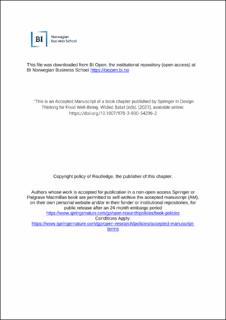| dc.contributor.author | Veflen, Nina | |
| dc.contributor.author | Ueland, Øydis | |
| dc.date.accessioned | 2022-05-11T13:07:26Z | |
| dc.date.available | 2022-05-11T13:07:26Z | |
| dc.date.created | 2021-01-20T12:20:49Z | |
| dc.date.issued | 2021 | |
| dc.identifier.citation | Chapter in: Design Thinking for Food Well-being: The Art of Designing Innovative Food Experiences. Ed. Batat Wided (2021) | en_US |
| dc.identifier.isbn | 978-3-030-54296-2 | |
| dc.identifier.uri | https://hdl.handle.net/11250/2995291 | |
| dc.description.abstract | Design thinking, the process of transforming deep user insight into new solutions by utilizing methods and mindsets borrowed from designers, has evolved to become one of the most rapidly spreading approaches for development globally. Today, design thinking is applied not only for product and service development but also for societal, political, and economic problems. In this chapter, we argue that design thinking can help to promote and enhance healthy food consumption experiences for vulnerable groups. To do so, we discuss three core elements of design thiking: empathy, visualization and collaboration. | en_US |
| dc.language.iso | eng | en_US |
| dc.publisher | Springer | en_US |
| dc.relation.ispartof | Design Thinking for Food Well-being: The Art of Designing Innovative Food Experiences | |
| dc.title | From Food Product to Food Experience: How to Use Design Thinking to Service Vulnerable Populations and Improve Their Food Well-Being | en_US |
| dc.type | Chapter | en_US |
| dc.description.version | acceptedVersion | en_US |
| dc.source.pagenumber | 7 | en_US |
| dc.identifier.doi | 10.1007/978-3-030-54296-2_16 | |
| dc.identifier.cristin | 1875378 | |
| cristin.ispublished | true | |
| cristin.fulltext | postprint | |
| cristin.qualitycode | 1 | |
